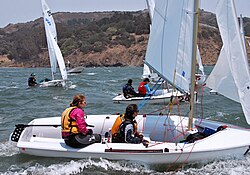Club 420
 Club 420 under sail | |
| Development | |
|---|---|
| Design | GRP |
| Role | Youth trainer, racing |
| Boat | |
| Crew | 2 |
| Draft | 0.965 metres (3 ft 2.0 in) |
| Trapeze | Single |
| Hull | |
| Type | Monohull |
| Hull weight | 230 pounds (100 kg) |
| LOA | 4.20 metres (13 ft 9 in) |
| Beam | 1.63 metres (5 ft 4 in) |
| Hull appendages | |
| Keel/board type | Centerboard |
| Rig | |
| Rig type | Bermuda |
| Mast length | 6.26 metres (20 ft 6 in) |
| Sails | |
| Mainsail area | 10.25 square metres (110.3 sq ft) |
| Jib/genoa area | 2.8 square metres (30 sq ft) |
| Spinnaker area | 8.83 square metres (95.0 sq ft) |
| Upwind sail area | 13.05 square metres (140.5 sq ft) |
The Club 420 is a derivative of the 420 that is popular in North America. The class is not recognized by International Sailing Federation or the International 420 Class Association and cannot be used at I420 class events. It is a strongly enforced class boat which the basis for the Club 420 class which has hundreds of local events and championship events throughout North America. The boats are very similar in appearance but the club 420 although is slightly stronger, heavier and less refined. A key difference is the decreased flexibility of the mast in the Club 420. Originally created by the Harken Brothers (Vanguard Boats) in the US they acquired a license to build the International 420 however they ended up producing the Club 420.vThe Club 420 forms the base of many local, high school and collegiate programs in North America. Simple and safe for beginning sailors and yet challenging enough for collegiate champions, the C420 offers more learning opportunities than any other double-handed boat in North America. Over 7,000 Club 420s are sailed in youth programs all over the United States, Canada and the Caribbean.
